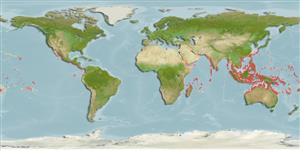Common names from other countries
>
Eupercaria/misc (Various families in series Eupercaria) >
Haemulidae (Grunts) > Plectorhinchinae
Etymology: Plectorhinchus: Greek, plektos = plaited + Greek, rhyngchos = snout (Ref. 45335).
More on author: Lacepède.
Environment: milieu / climate zone / depth range / distribution range
Ecologia
marino; acqua dolce; salmastro associati a barriera corallina; distribuzione batimetrica 8 - 25 m (Ref. 58652). Tropical; 30°N - 24°S
Indo-West Pacific: Red Sea to Natal, South Africa (including Madagascar and the Comoro and Reunion islands); Gulf of Aden and the Persian Gulf eastward to Samoa, north to the Ryukyu Islands, south to Australia; Caroline and Mariana islands in Micronesia.
Size / Peso / Age
Maturity: Lm ? range ? - ? cm
Max length : 75.0 cm TL maschio/sesso non determinato; (Ref. 30874)
Spine dorsali (totale) : 14; Raggi dorsali molli (totale) : 15 - 16; Spine anali: 3; Raggi anali molli: 7 - 8.
Found in coastal reefs, sandbanks, and near estuaries (Ref. 30573). Enter freshwater (Ref. 7050). Small juveniles occur along sheltered sandy shorelines where they mimic a dead leaf by drifting on their sides (Ref. 37816). Adults mainly in protected inshore reefs to deep offshore, sometimes swims in small groups (Ref. 48635). Excellent food fish (Ref. 2799).
Life cycle and mating behavior
Maturities | Riproduzione | Spawnings | Egg(s) | Fecundities | Larve
Oviparous, distinct pairing during breeding (Ref. 205).
Myers, R.F., 1991. Micronesian reef fishes. Second Ed. Coral Graphics, Barrigada, Guam. 298 p. (Ref. 1602)
IUCN Red List Status (Ref. 130435)
CITES (Ref. 128078)
Not Evaluated
Threat to humans
Reports of ciguatera poisoning (Ref. 2799)
Human uses
Pesca: commerciale; Pesce da pesca sportiva: si
Strumenti
Special reports
Download XML
Fonti Internet
Estimates based on models
Preferred temperature (Ref.
115969): 25.2 - 29.3, mean 28.4 (based on 3703 cells).
Phylogenetic diversity index (Ref.
82804): PD
50 = 0.5000 [Uniqueness, from 0.5 = low to 2.0 = high].
Bayesian length-weight: a=0.01995 (0.01110 - 0.03588), b=2.93 (2.77 - 3.09), in cm Total Length, based on LWR estimates for this species & (Sub)family-body (Ref.
93245).
Trophic level (Ref.
69278): 3.6 ±0.5 se; based on diet studies.
Resilienza (Ref.
120179): Medio, tempo minimo di raddoppiamento della popolazione 1.4 - 4.4 anni (K=0.20).
Fishing Vulnerability (Ref.
59153): Moderate to high vulnerability (45 of 100).
